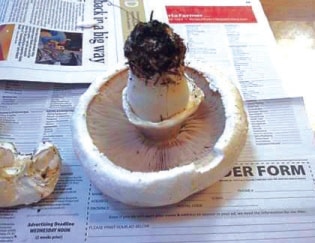Submitted by Charles Bird
This being winter, we long to get out and tramp through the woods. It is the time of year when so much of nature is "asleep". This "nature note" is about mushrooms and, in particular, about ones of the genus Agaricus. In Alberta, we have nearly ten species, the commonest of which are arvensis (the horse mushroom), campestris (the field mushroom) and silvicola (the wood mushroom). The one shown here is the horse mushroom.
In most grocery stores, you can buy three kinds of mushrooms, the common white button mushroom, creminis and portobellos. All belong to the species Agaricus bisporus. The latter two are strains that are brown in color. The last one is large and is sold when mature.
Mushrooms start from spores which germinate to grown into hyphae. The hyphae grow in the substrate where they absorb nutrients from dead organic matter. When conditions are right, the hyphae come together at to grow into the above-ground structures we associate with mushrooms. Like most mushrooms, including the Agarics, these are a stalk (stipe) and a cap (pileus). The stalk may have a ring (annulus) as in the above illustration. The underside of the cap has a hymenium made up of gills (lamellae). Spore bearing structures (basidia) are born on the gills and they produce basidiospores.
Most mushrooms are saprophytes and, as such, are part of nature's very important recycling crew that helps turns dead plant material into fertile soil.
Though Agaricus bisporus bought in stores is good to eat some wild species that are poisonous or will make you ill. No wild mushroom should be eaten unless you are quite sure you know of it's identity. It is also a good idea to never eat any wild mushroom raw as cooking may denature poisonous components.
In the wild, many species eat mushrooms. Be aware that some flies lay eggs on them and the developing maggots gather in the caps causing them to be "wormy".
There are a number of good mushroom books that can be used for determination. For those of us in Alberta, my favourite is Helene Schalkwijk-Barendsen's "Mushrooms of Northwest North America".
One of the best natural areas in west-central Alberta is the J.J. Collett Natural Area. Their website, http://www.jjcollett.com/, has a checklist of the mushrooms that have been found there.
Mycologists are folks that are interested in mushrooms and other fungi. There is an Alberta Mycological Society. It's website is http://www.wildmushrooms.ws/.
Mushrooms are fun. Watch for them this summer and early fall.
